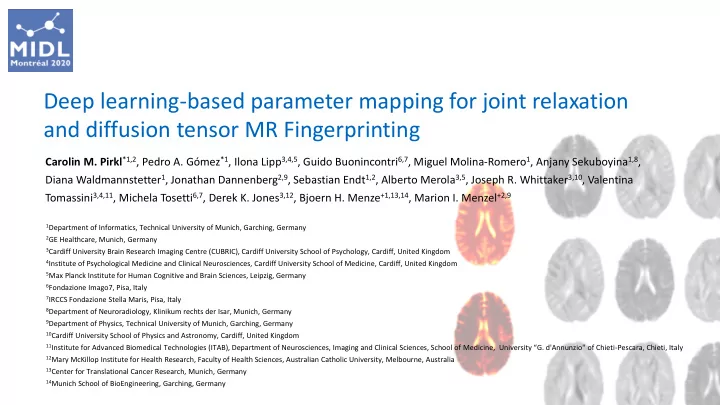

Deep learning-based parameter mapping for joint relaxation and diffusion tensor MR Fingerprinting Carolin M. Pirkl *1,2 , Pedro A. Gómez *1 , Ilona Lipp 3,4,5 , Guido Buonincontri 6,7 , Miguel Molina-Romero 1 , Anjany Sekuboyina 1,8 , Diana Waldmannstetter 1 , Jonathan Dannenberg 2,9 , Sebastian Endt 1,2 , Alberto Merola 3,5 , Joseph R. Whittaker 3,10 , Valentina Tomassini 3,4,11 , Michela Tosetti 6,7 , Derek K. Jones 3,12 , Bjoern H. Menze +1,13,14 , Marion I. Menzel +2,9 1 Department of Informatics, Technical University of Munich, Garching, Germany 2 GE Healthcare, Munich, Germany 3 Cardiff University Brain Research Imaging Centre (CUBRIC), Cardiff University School of Psychology, Cardiff, United Kingdom 4 Institute of Psychological Medicine and Clinical Neurosciences, Cardiff University School of Medicine, Cardiff, United Kingdom 5 Max Planck Institute for Human Cognitive and Brain Sciences, Leipzig, Germany 6 Fondazione Imago7, Pisa, Italy 7 IRCCS Fondazione Stella Maris, Pisa, Italy 8 Department of Neuroradiology, Klinikum rechts der Isar, Munich, Germany 9 Department of Physics, Technical University of Munich, Garching, Germany 10 Cardiff University School of Physics and Astronomy, Cardiff, United Kingdom 11 Institute for Advanced Biomedical Technologies (ITAB), Department of Neurosciences, Imaging and Clinical Sciences, School of Med icine, University “G. d'Annunzio" of Chieti -Pescara, Chieti, Italy 12 Mary McKillop Institute for Health Research, Faculty of Health Sciences, Australian Catholic University, Melbourne, Australia 13 Center for Translational Cancer Research, Munich, Germany 14 Munich School of BioEngineering, Garching, Germany
Introduction | Relaxation and diffusion MR Fingerprinting MR Fingerprinting (MRF) Ma et al. Nature (2013) Jiang et al. Magn Reson Med (2015) Diffusion-weighted MRF Jiang et al. ISMRM (2014, 2016, 2017) Cohen et al. ISMRM (2018) Rieger et al. ISMRM (2018) Deep learning-based parameter mapping for joint relaxation and diffusion tensor MR Fingerprinting Pirkl, Gómez et al. MIDL (2020) 2
Methods | Diffusion-sensitized MRF sequence Acquisition parameters 1.2 1.2 5 mm 3 resolution • 22.5 22.5 cm 2 FOV • • Variable density spiral sampling (34 interleaves) • 30 diffusion encoding directions • TI = 18ms, TE = 6ms • 32s / slice acquisition time Sliding window reconstruction • Window size = 34 • Window stride = 34 3 McNab & Miller NMR Biomed (2010), Bieri et al. Magn Reson Med (2012), Gómez et al. ISMRM (2017)
Methods | CNN-based parameter mapping Quantitative relaxation and diffusion tensor reference maps 𝒛 MRF image-series 𝒚 𝒚 ∈ ℝ 256×256×𝑈 , 𝒛 ∈ ℝ 256×256×𝑅 , 𝑈 = 36 temporal channels 𝑅 = 8 quantitative channels 𝒛 𝑟 𝒚 − min(𝒚) 𝒚 ′ = 𝒛′ 𝑟 = max( 𝑟 𝑛𝑗𝑜 , 𝑟 𝑛𝑏𝑦 ) max 𝒚 − min(𝒚) Dataset • 11 MS patients, 9 healthy volunteers • 8-12 slices / subject Experimental setup + CNN training • 10-fold cross validation • L1 loss • Learning rate = 1e-4 • Dropout rate = 0.25 • Batch size = 5 • 400 epochs Ronneberger et al. MICCAI (2015), Deoni. JMRI (2007), Deoni et al. Magn Reson Med (2003) 4
Results | Qualitative evaluation Relaxation and diffusion tensor maps • High consistency between CNN prediction and state-of-the-art reference • CNN reliably reconstructs relaxation and orientational diffusion information Scalar diffusion metrics Good agreement with EPI-DTI reference Colored FA maps + primary diffusion eigenvectors Characteristic fiber structure in WM is captured 5
Results | Quantitative evaluation Quantitative evaluation substantiates qualitative findings • Reliably reconstruction of relaxation and orientational diffusion information, also in regions of diagnostic importance (MS lesions) → Generalization capability • Comparable reconstruction performance for T1 and T2 with respect to DESPOT1/2 methods • Better agreement with EPI-DTI reference for diagonal diffusion tensor elements (D xx , D yy , D zz ) than off-diagonal elements (D xy , D xz , D yz ) 6
Discussion and outlook Thank you! Relaxation and diffusion-sensitized MRF sequence CNN-based multivariate regression ✓ Relax MR acquisition requirements Outlook: Improve on our baseline ✓ Efficiently encode: • More advanced deep learning approaches • T1 and T2 relaxation times • More efficient, motion-robust diffusion • Orientational diffusion information encoding scheme ✓ Bypass conventional dictionary matching Major challenge: Severe head motion → Prospective and retrospective motion correction approaches → Increase motion robustness of sequence design 7
Recommend
More recommend